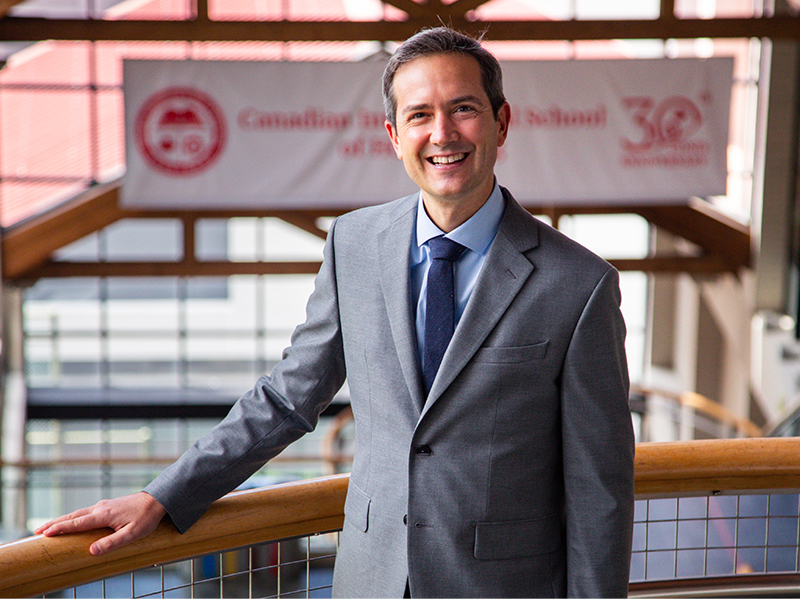One of Hong Kong’s prominent international schools celebrates a big milestone this year. The Canadian International School of Hong Kong (CDNIS) opened its doors back in 1991, so the academic year 2021/22 happens to be its 30th birthday. To mark the occasion, there are some significant changes afoot at the school, including the introduction of a bilingual programme for younger learners. We chat with LIEF ERICKSON, Lower School Principal at CDNIS, to find out more about these, and about his own teaching experiences in HK.

Where are you from originally, and how long have you been in Hong Kong? Where did you teach before CDNIS in HK?
I’m from Oregon in the United States, but I’ve worked in eight different countries. In fact, my entire career has been overseas, always in education. My wife and I met in Thailand working at the same school; we’ve also been in the Middle East and then Europe for a long time, most recently in Switzerland.
CDNIS turns 30 this year; tell us about some of the things that are going on.
We’re very excited to be celebrating our 30th anniversary. The school has never been one to rest on its laurels, and this year is no exception. Starting next August, we’re making some changes in our Early Years Programme (EY1 and EY2) and rolling those up to our Lower Preparatory class in August 2023.
Next year in EY1, our programme for three-year-olds, we will continue with our international track, which is 80% English and 20% Mandarin Chinese, but we will also introduce a bilingual track, which will be 50% English and 50% Chinese. Since these are half-day classes, students in the bilingual programme will be immersed in English one day and Chinese the next. Instead of having one language teacher in the room at all times, the class will be fully immersed in the language that day.
What was the motivation for the change?
Research shows that when you have two teachers in the classroom, children tend to tune into their more dominant language instead of being confident to express themselves in the other language. That’s one of the reasons we’ve gone for the full immersion model instead of having both teachers in the room at the same time.
With the immersion model, the teacher will always stay in the language of instruction. So, if it’s a Chinese day, they’ll speak (and sing and dance!) in Chinese all day long. They will use gestures, symbols, puppets – all the different kinds of play-based learning options that the EYE (Early Years Environment) provides. If a child doesn’t yet have the language skills to express themselves, they can speak in English, and the teacher will respond in Chinese. There are also no entry requirements; we’re welcoming everyone to the bilingual class, even those with no prior knowledge of Chinese.
This will build nicely on our already successful Early Years programme. Until now, Chinese has been taught as a specialist language: you go to Chinese, you have a language lesson, and then you come out of that lesson. Now, the homeroom teacher will be the one using the language throughout the day, from the moment the children come in. So, the morning meeting will be in the language, along with all the social and emotional development activities you’d normally structure in a day.
Why did you decide to add a dual language option at this time?
There’s a growing demand for a strong foundation in Mandarin Chinese from our parent community, as well as our graduates who are going to university or into the workforce. Having a strong foundation in Chinese opens up more doors. It’s also the right time to learn the language when you’re younger.
What about changes being made to the EY2 programme?
There are quite a few changes in store for our EY2 programme, which is for four-year-olds. Along with offering a half-day bilingual track, we are also introducing a full-day programme for the first time. Up until now, we’ve had a morning class and an afternoon class; those will continue, but we’ll also offer a full-day bilingual class.
All the stars seem to have aligned for this pilot programme. The market demand is there; we found parents in our morning class were already taking their children somewhere else in the afternoon. Plus, the homeroom teachers and educators have been wanting more time to help the children socially and emotionally and give them extra opportunities. The full-day programme includes lunch and afternoon recess, which are important learning engagements in the Early Years as the children eat together, move around and socialise.
Any plans to expand the bilingual programme?
Yes, we will be rolling out the bilingual programme into our Preparatory class from the following year; then, over the next two years, we will be evaluating and considering if we’ll roll it out to the rest of the Lower School. The demand for a bilingual programme, from EY1 right up to Grade 5, is there.
Aside from these additions, how else will CDNIS be celebrating 30 years?
We’re going to hold a variety of events – at least 30 of them! We decided because of the pandemic that we wouldn’t do a single major gala or event in case it got cancelled. Instead, we’re focusing on storytelling, highlighting things from our past and having events with our community throughout the year. The storytelling aspect will involve families in our community and especially our alumni and what they’re up to; this includes quite a number of alumni who are now putting their own children into the school!
What do you enjoy most about working at CDNIS?
This school has a very special community spirit. Students, staff and parents are highly engaged and collaborative, and I love how everyone shares the common goal of striving for the best we can for our students.
CDNIS campus is in a spectacular location (and keeps everyone fit!); do you have a favourite place on campus?
It would have to be the EYE, especially as a Lower School Principal. Any time I’m wrapped up in back-to-back meetings or I’m just having one of those days, if I walk into there and see our three- and four-year-olds, how can you not have a smile on your face? It’s just a great reminder of why I do what I do.
What do you like to do in HK when you’re not busy at school?
My wife and I are avid hikers; being new to Hong Kong, we have enjoyed exploring the beaches, city, trails and of course the food options!
The Canadian International School of Hong Kong is at 36 Nam Long Shan Road, Aberdeen.
2525 7088 | cdnis.edu.hk
Like this? See more in our Kids section!






